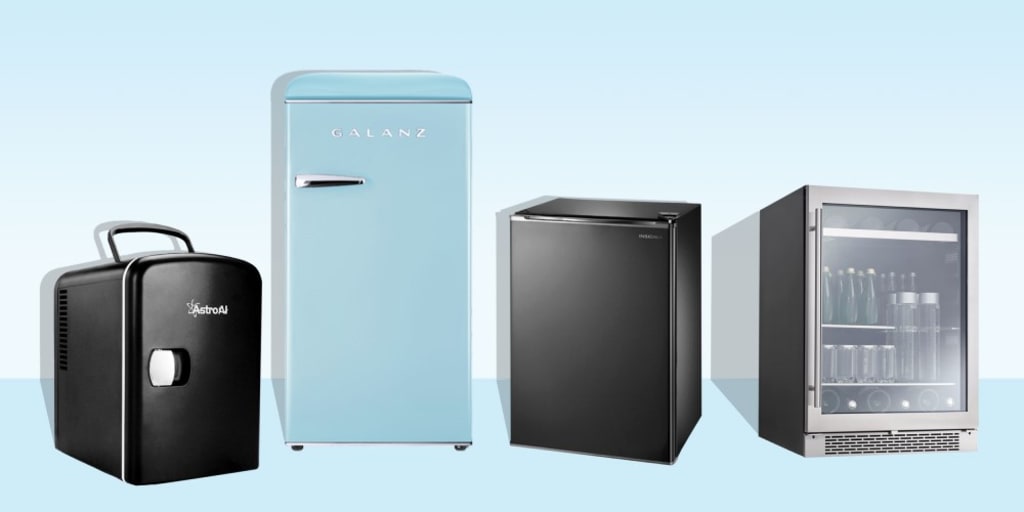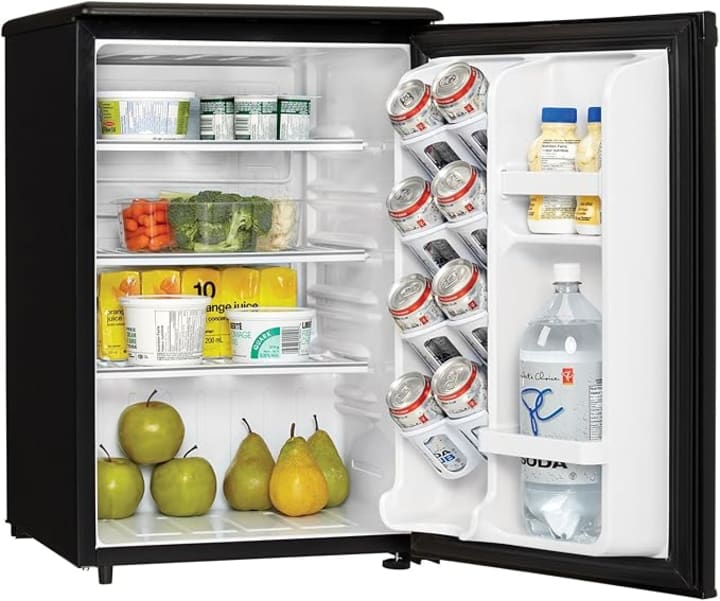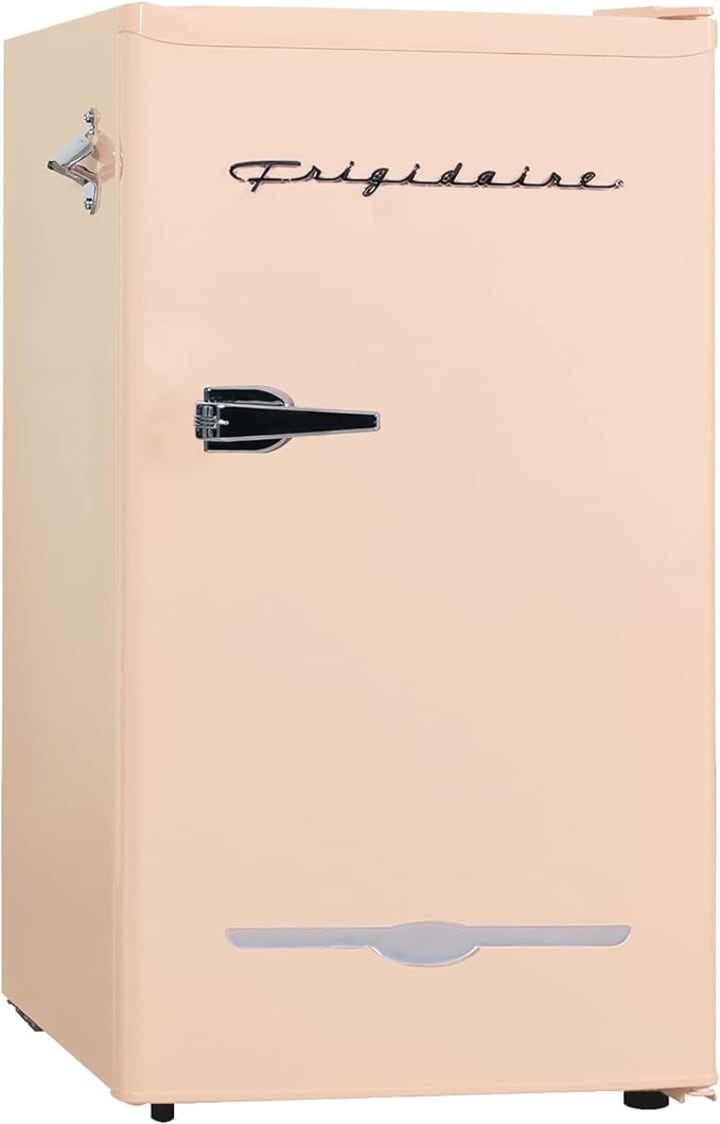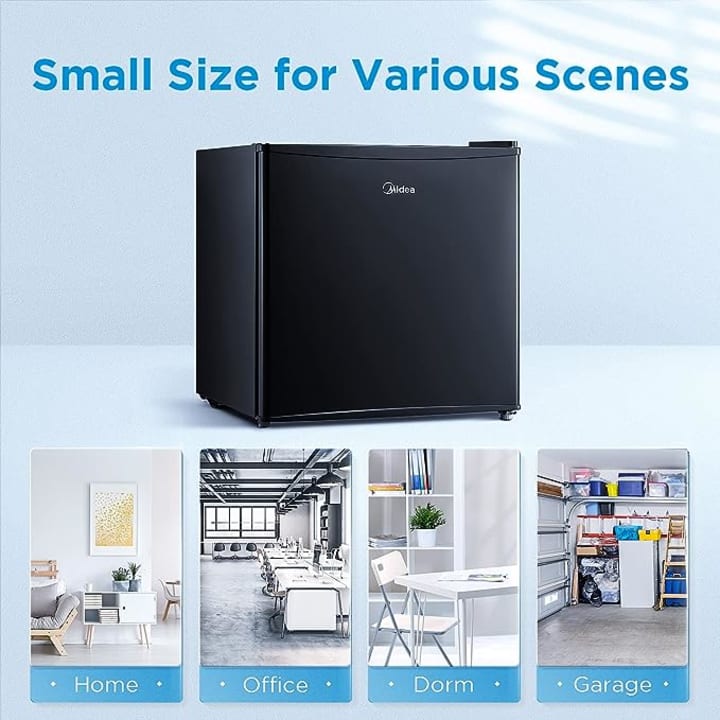The Ultimate Guide to Mini Fridges
Choosing, Using, and Maintaining Your Compact Cooling Companion

Introduction:
Mini fridges, also known as compact refrigerators, have become an essential appliance in many households, offices, and dorm rooms. These versatile units offer the convenience of refrigeration in a smaller, more manageable size, making them ideal for spaces where a full-sized refrigerator might be impractical or unnecessary. With advancements in technology and design, mini fridges now come with a variety of features that enhance their functionality and appeal.
The growing popularity of mini fridges can be attributed to their wide range of uses and benefits. In homes, they serve as convenient beverage and snack stations, keeping frequently used items within easy reach. In office settings, they provide employees with a place to store lunches and refreshments, promoting a more comfortable and efficient workspace. College students find mini fridges indispensable for storing perishables and beverages in their dorm rooms, while outdoor enthusiasts appreciate their portability for camping trips and outdoor events.
As lifestyles continue to evolve, the demand for compact, efficient, and versatile refrigeration solutions is on the rise. Mini fridges are meeting this demand, proving that good things do indeed come in small packages.
What is a Mini Fridge?
A mini fridge, also known as a compact refrigerator, is a small-sized appliance designed to refrigerate and sometimes freeze food and beverages. Typically ranging in height from about 18 to 36 inches, mini fridges are significantly smaller than standard refrigerators, making them ideal for limited spaces like dorm rooms, offices, bedrooms, and small apartments.
Comparison with Standard Refrigerators
Size and Capacity: Standard refrigerators are much larger, usually standing between 60 to 70 inches tall and offering more storage space. Mini fridges, on the other hand, are compact and designed to fit in tight spaces, offering a smaller capacity that typically ranges from 1.7 to 4.5 cubic feet.
Energy Consumption: Due to their smaller size, mini fridges generally consume less energy than full-sized refrigerators. However, their efficiency can vary depending on the model and features.
Portability: Mini fridges are lightweight and portable, making them easy to move and place in various locations. Standard refrigerators are heavy and bulky, requiring more effort and planning to relocate.
Usage: Standard refrigerators are suited for household kitchens, providing ample space for a family's food storage needs, including fresh produce, dairy, meats, and frozen goods. Mini fridges are ideal for supplemental use, such as storing beverages, snacks, or personal items in secondary locations.
In summary, while mini fridges may not replace the full functionality of a standard refrigerator, their compact size and convenience make them a valuable addition to many different environments
Types of Mini Fridges:
Description and Uses: Cube mini fridges are the smallest type of mini fridge, typically with a capacity of around 1.5 to 2.5 cubic feet. Their compact, box-like design makes them perfect for small spaces such as dorm rooms, offices, and bedrooms. They are commonly used to store beverages, snacks, and small food items.
Pros:
Extremely compact and portable
Affordable
Fits in tight spaces
Cons:
Limited storage capacity
Often lack a freezer compartment
Less energy-efficient compared to larger models
Description and Uses: Mid-size mini fridges are larger than cube models, offering a capacity of around 3 to 4.5 cubic feet. They often include a small freezer compartment and more shelving options, making them suitable for more extensive storage needs in apartments, offices, and shared living spaces.
Pros:
More storage space
Often includes a freezer compartment
Better energy efficiency than cube models
Cons:
Larger footprint requires more space
Heavier and less portable than cube models
Description and Uses: Countertop mini fridges are designed to sit on countertops or other elevated surfaces, with a capacity typically ranging from 1 to 2 cubic feet. They are ideal for keeping beverages, snacks, and small food items within easy reach in kitchens, offices, or entertainment areas.
Pros:
Convenient for countertop use
Compact and space-saving
Easily accessible
Cons:
Limited storage capacity
May lack advanced features like temperature control
Description and Uses: Travel mini fridges are portable, lightweight fridges designed for use in vehicles, RVs, and outdoor settings. They usually have a capacity of 1 to 1.5 cubic feet and can be powered by a car's DC outlet or a portable power source. These fridges are perfect for road trips, camping, and outdoor activities.
Pros:
Highly portable and lightweight
Can be powered by a car's DC outlet
Ideal for travel and outdoor use
Cons:
Limited storage capacity
May not cool as efficiently as larger models
Typically lacks a freezer compartment
Each type of mini fridge offers unique advantages and is suited for different needs and environments. Choosing the right one depends on your specific requirements, space availability, and intended use.
Key Features to Consider:
Size and Capacity
When choosing a mini fridge, it's crucial to consider its size and capacity to ensure it meets your storage needs. Mini fridges come in various sizes, typically ranging from 1.5 to 4.5 cubic feet. To determine the right size for your needs:
Assess Your Storage Needs: Consider what you plan to store. If you need space for beverages and snacks, a smaller model might suffice. For storing larger items or more food, opt for a mid-size mini fridge.
Measure Your Space: Ensure the fridge fits in the intended location by measuring the available space. Don’t forget to account for ventilation space around the unit.
Energy Efficiency
Energy efficiency is an essential factor as it affects both your electricity bill and environmental footprint.
Energy Ratings: Look for mini fridges with Energy Star ratings, which indicate that the appliance meets energy efficiency guidelines set by the U.S. Environmental Protection Agency. Energy-efficient models consume less electricity, saving you money in the long run.
Cooling Technology
Mini fridges utilize different cooling technologies, each with its own benefits and drawbacks.
Compressor-Based Cooling: Similar to standard refrigerators, compressor-based mini fridges are highly efficient and effective at maintaining consistent temperatures, including freezing. They are ideal for use in kitchens and other settings where reliable cooling is needed.
Thermoelectric Cooling: These models are quieter and more energy-efficient but are typically less effective at maintaining very low temperatures. They are suitable for storing beverages and snacks in quieter environments like bedrooms or offices.
Noise Levels
The noise level of a mini fridge is an important consideration, especially if it will be placed in a bedroom, office, or any other quiet space.
Noise Ratings: Check the decibel (dB) rating of the fridge. Models with lower dB ratings are quieter and more suitable for environments where noise is a concern.
Additional Features
Additional features can enhance the functionality and convenience of your mini fridge.
Adjustable Shelves: Shelves that can be repositioned or removed allow for more flexible storage arrangements, accommodating items of various sizes.
Door Storage: Door compartments provide extra storage for smaller items like cans, bottles, and condiments, maximizing the available space within the fridge.
Freezer Compartment: Some mini fridges come with a small freezer compartment, which is useful for storing frozen foods or making ice. This feature is particularly valuable if you need a more versatile appliance.
By considering these key features, you can select a mini fridge that perfectly suits your needs, providing efficient and convenient refrigeration in a compact form.
Benefits of Owning a Mini Fridge:
Owning a mini fridge brings a host of advantages that go beyond just keeping your drinks cold. These compact wonders offer practical solutions and convenience for various settings. Here’s why you should consider adding a mini fridge to your life:
Space-Saving
Maximize your space without sacrificing functionality. Mini fridges are designed to fit in tight spots where full-sized fridges can't go, making them perfect for small apartments, dorm rooms, offices, and even bedrooms. Their compact size allows you to have refrigeration right where you need it without cluttering your space.
Portability
Take cool wherever you go. Mini fridges are lightweight and easy to move, making them ideal for people on the go. Whether you're moving to a new place, setting up an office, or planning a road trip, a mini fridge can be effortlessly relocated to meet your needs.
Energy Efficiency
Save money while being eco-friendly. Mini fridges consume less power compared to their full-sized counterparts, helping you save on electricity bills. Many models come with Energy Star ratings, ensuring they operate efficiently while reducing your carbon footprint.
Versatility in Usage
Adaptable for every lifestyle. Mini fridges are incredibly versatile, serving a variety of purposes in different settings. Use them to store snacks and drinks in your home, keep your lunch fresh at the office, provide easy access to essentials in dorm rooms, or even chill your refreshments during outdoor activities and camping trips. Their adaptability makes them a valuable addition to any environment.
Incorporating a mini fridge into your life means enjoying the perfect blend of convenience, efficiency, and versatility. From saving space to reducing energy consumption, the benefits of owning a mini fridge are simply irresistible.
Top Uses for Mini Fridges:
Mini fridges are incredibly versatile and can be used in a variety of settings to enhance convenience and organization. Here are some of the top uses for these compact appliances:
Dorm Rooms
Keep your snacks and beverages close at hand. In the limited space of a dorm room, a mini fridge provides essential storage for perishables, leftovers, and drinks, ensuring students have easy access to their food without leaving their room.
Offices
Enhance your workspace with convenience. A mini fridge in the office allows you to store your lunch, snacks, and refreshments, reducing the need for trips to the communal kitchen or vending machine. This can boost productivity and make break times more enjoyable.
Bedrooms
Enjoy midnight snacks without leaving your bed. A mini fridge in the bedroom is perfect for keeping water, beverages, and light snacks within arm's reach, especially useful for those who prefer not to go to the kitchen late at night.
Garages and Workshops
Keep your refreshments cool while you work. A mini fridge in the garage or workshop ensures you have cold drinks and snacks available during long projects or hot days, without the need to go inside the house.
Outdoor Events and Camping
Take cool on the go. Portable mini fridges are ideal for outdoor events, picnics, and camping trips. They keep your food and drinks chilled in the car, at the campsite, or during tailgating parties, making outdoor activities more enjoyable and convenient.
Personal Skincare Products
Preserve your beauty essentials. A mini fridge dedicated to skincare products helps maintain their freshness and effectiveness by keeping them at an optimal temperature. This is particularly beneficial for products like face masks, creams, and serums, enhancing their soothing effects when applied cool.
Incorporating a mini fridge into these various settings can greatly improve your lifestyle by providing convenient access to chilled items, increasing efficiency, and adding a touch of luxury and practicality to everyday activities.
Top Mini Fridge Brands and Models:
When shopping for a mini fridge, it’s important to consider reputable brands known for their quality, reliability, and innovative features. Here’s an overview of some of the top brands and detailed reviews of standout models.
Overview of Reputable Brands
Danby: Known for their durable and energy-efficient mini fridges, Danby offers a variety of sizes and styles to fit different needs.
Whirlpool: A trusted name in household appliances, Whirlpool’s mini fridges are known for their reliability and performance.
Frigidaire: Offers a range of compact refrigerators with sleek designs and advanced cooling technologies.
Black + Decker: Provides affordable and functional mini fridges suitable for dorm rooms, offices, and bedrooms.
Midea: Known for their high-quality, energy-efficient mini fridges with modern features and stylish designs.
Detailed Reviews of Top Models:
Model A: Danby Designer DAR026A1BDD-3 Compact Refrigerator
Features:
Capacity: 2.6 cubic feet
Dimensions: 20.07 x 17.68 x 26.96 inches
Energy Efficiency: Energy Star rated for efficient energy consumption
Design: Sleek black finish with a spotless steel door that mimics stainless steel
Interior: Adjustable wire shelves, a full-width freezer section, and integrated door shelving
Additional Features: Mechanical thermostat, interior light, and reversible door hinge
Pros:
Energy-efficient, saving on electricity bills
Compact size fits well in small spaces
Adjustable shelves allow for flexible storage options
Quiet operation
Cons:
Freezer section is small, suitable only for limited frozen items
Mechanical thermostat may require manual adjustments for optimal cooling

Model B: Frigidaire EFR331-BLACK 3.2 Cu Ft Pink Retro Bar Fridge with Side Bottle Opener
Features:
Capacity: 3.2 cubic feet
Dimensions: 22 x 20.5 x 35 inches
Design: Retro style with a sleek black finish and chrome accents
Interior: Two adjustable glass shelves, a freezer compartment, and door storage for beverages
Additional Features: Built-in bottle opener on the side, reversible door
Pros:
Stylish retro design adds a unique touch to any space
Spacious interior with adjustable shelving
Convenient built-in bottle opener
Quiet and efficient cooling
Cons:
Higher price point compared to other mini fridges
Freezer compartment may not be suitable for long-term storage of frozen items

Model C: Midea WHS-65LB1 Compact Single Reversible Door Refrigerator
Features:
Capacity: 1.6 cubic feet
Dimensions: 17.7 x 18.6 x 19.4 inches
Energy Efficiency: Energy Star rated
Design: Black or white finish with a sleek, simple design
Interior: Adjustable shelves, full-width chiller compartment, and door storage for bottles and cans
Additional Features: Reversible door, adjustable thermostat
Pros:
Compact and lightweight, easy to move and fit into small spaces
Energy-efficient operation
Adjustable shelving for flexible storage
Affordable price
Cons:
Smaller capacity, suitable for limited items
Chiller compartment is not as effective as a full freezer

These top models from reputable brands offer a range of features and benefits to suit different needs and preferences, making them excellent choices for anyone in the market for a mini fridge.
Maintenance and Care Tips for Mini Fridges:
Proper maintenance and care can extend the lifespan of your mini fridge and ensure it operates efficiently. Here are some essential tips for cleaning, defrosting, placement, ventilation, and troubleshooting common issues.
Cleaning & Defrosting
Cleaning:
Unplug the Fridge: Always unplug the mini fridge before cleaning to ensure safety.
Remove Contents: Take out all food, drinks, and removable shelves or drawers.
Clean Interior: Use a mixture of warm water and mild dish soap to clean the interior surfaces. Avoid using harsh chemicals or abrasive scrubbers that can damage the finish.
Shelves and Drawers: Wash removable shelves and drawers in warm, soapy water. Rinse and dry them thoroughly before putting them back.
Door Seals: Clean the door seals with a damp cloth to remove any dirt or grime that could affect the fridge’s efficiency.
Exterior: Wipe down the exterior with a damp cloth and mild detergent, then dry with a clean towel.
Defrosting:
Unplug the Fridge: Turn off and unplug the fridge to start the defrosting process.
Remove Ice: If the mini fridge has a freezer compartment, let the ice melt naturally or use a bowl of hot water placed inside to speed up the process.
Dry the Interior: Once defrosted, wipe away any water and dry the interior thoroughly before plugging the fridge back in and restocking it.
Placement and Ventilation
Placement:
Stable Surface: Place the mini fridge on a flat, stable surface to prevent vibrations and noise.
Avoid Heat Sources: Keep the fridge away from direct sunlight, stoves, and other heat sources, which can make it work harder and reduce efficiency.
Ventilation:
Space Around the Fridge: Ensure there is adequate space around the mini fridge for proper air circulation. A few inches of space on all sides are usually recommended.
Clean Vents: Regularly check and clean any vents or coils at the back of the fridge to prevent dust buildup that can affect performance.
Troubleshooting Common Issues:
Not Cooling Properly:
Check the Thermostat: Make sure the thermostat is set to the correct temperature.
Overloaded Fridge: Avoid overloading the fridge, as this can obstruct airflow and reduce cooling efficiency.
Door Seals: Inspect the door seals for any gaps or damage that could be letting warm air in.
Strange Noises:
Level the Fridge: Ensure the fridge is placed on a level surface.
Check for Loose Parts: Look for any loose parts or items inside the fridge that could be causing noise.
Water Leaks:
Defrost Drain: Check the defrost drain to ensure it is not clogged.
Condensation: Excessive condensation can occur if the door is frequently opened or not sealed properly.
Frost Buildup:
Defrost Regularly: If your mini fridge doesn’t have an automatic defrost function, defrost it regularly to prevent excessive frost buildup.
Door Seals: Ensure the door seals are intact and closing properly to prevent warm air from entering and causing frost.
By following these maintenance and care tips, you can keep your mini fridge running smoothly and efficiently for years to come.
Buying Guide for Mini Fridges:
When purchasing a mini fridge, it's important to consider where to buy it, how much to spend, and the warranty and return policies. Here's a comprehensive guide to help you make an informed decision.
Where to Buy
Online Retailers:
Amazon: Offers a wide variety of brands and models with customer reviews and ratings. Often provides competitive prices and fast shipping.
Best Buy: Features a good selection of mini fridges, along with detailed product descriptions and user reviews. In-store pickup and delivery options are available.
Walmart: Sells a range of affordable mini fridges from various brands. Convenient for both online ordering and in-store shopping.
Home Depot: Provides a selection of mini fridges with the option to buy online and pick up in-store, or have it delivered.
Physical Stores:
Electronics Stores: Places like Best Buy often have mini fridges on display, allowing you to see the product in person before buying.
Home Appliance Stores: Stores like Lowe's and Home Depot offer a range of mini fridges, with knowledgeable staff to assist with your purchase.
Department Stores: Retailers like Target and Walmart offer mini fridges, often at competitive prices.
Price Range and Budgeting Tips:
Price Range:
Basic Models: $50 - $100. These are typically small, cube-shaped fridges with limited features, suitable for light use.
Mid-Range Models: $100 - $200. These fridges offer more capacity, better energy efficiency, and additional features like adjustable shelves and small freezer compartments.
High-End Models: $200 - $500. These include larger mini fridges with advanced features such as separate freezer sections, digital temperature controls, and stylish designs.
Budgeting Tips:
Assess Your Needs: Determine what you need in a mini fridge (size, features, energy efficiency) and set a budget accordingly.
Look for Sales and Discounts: Keep an eye out for sales events like Black Friday, Cyber Monday, or seasonal sales where mini fridges might be discounted.
Consider Refurbished Models: Some retailers offer refurbished units at a lower cost, which can be a great way to save money while still getting a reliable product.
Energy Efficiency: Investing in an energy-efficient model may cost more upfront but will save you money on electricity bills over time.
Warranty and Return Policies:
Warranty:
Manufacturer’s Warranty: Most mini fridges come with a manufacturer’s warranty that typically lasts one year. This covers defects in materials and workmanship.
Extended Warranties: Some retailers offer extended warranties for an additional cost, which can provide coverage for a longer period and protect against more issues.
Return Policies:
Retailer Policies: Check the return policy of the retailer where you purchase the mini fridge. Many offer a 30-day return window, but policies can vary.
Keep the Packaging: Retain the original packaging and receipt in case you need to return the fridge. Some retailers require these for returns or exchanges.
Inspect on Arrival: When your mini fridge arrives, inspect it immediately for any damage or defects. Contact the retailer or manufacturer promptly if there are any issues.
By considering these factors, you can make a well-informed decision when purchasing a mini fridge, ensuring that it meets your needs and budget while providing peace of mind with warranty and return policies.
Conclusion:
Choosing the right mini fridge can greatly enhance convenience and efficiency in your daily life, whether at home, in the office, or on the go. Here’s a recap of the benefits and importance, along with final tips and recommendations to guide your decision.
Recap of Benefits and Importance
Mini fridges offer several key benefits:
Space-Saving: Perfect for small spaces like dorm rooms, offices, and bedrooms where a full-sized fridge isn’t practical.
Portability: Easy to move and relocate, making them ideal for various settings and activities, including outdoor events and camping.
Energy Efficiency: Many models are energy-efficient, helping you save on electricity bills while reducing your carbon footprint.
Versatility: Suitable for a wide range of uses, from storing beverages and snacks to preserving skincare products and more.
Choosing the right mini fridge ensures you have convenient access to chilled items wherever you need them, enhancing organization and comfort in your living or working space.
About the Creator
Enjoyed the story? Support the Creator.
Subscribe for free to receive all their stories in your feed. You could also pledge your support or give them a one-off tip, letting them know you appreciate their work.





Comments
There are no comments for this story
Be the first to respond and start the conversation.